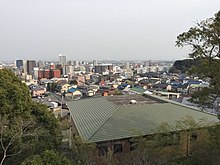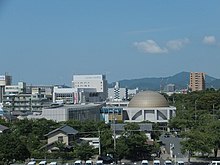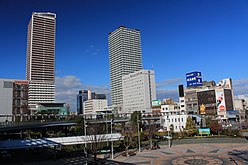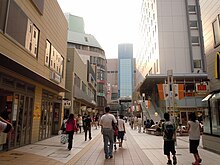Chūkyō metropolitan area
Chūkyō metropolitan area
中京圏 | |
|---|---|
 Nagoya | |
 | |
| Country | |
| Prefecture | Aichi |
| Area | |
| • Metro | 7,072 km2 (2,731 sq mi) |
| Population (Demographia World Urban Areas 2019
[http://demographia.com/db-worldua.pdf]) | |
| • Metro | 10,110,000 |
| • Metro density | 1,430/km2 (3,701/sq mi) |
| GDP[1] | |
| • Metro | JP¥57,460 billion (2021) US$523 billion (2021) |
Chūkyō (中京圏, Chūkyō-ken), or the Chūkyō region (中京地方, Chūkyō-chihō), is a major metropolitan area in Japan that is centered on the city of Nagoya (the "Chūkyō", i.e., the "capital in the middle") in Aichi Prefecture. The area makes up the most urbanized part of the Tōkai region. The population of 10,110,000 over an area of 7,072 square kilometers.[2] Nevertheless, like most of Japan's major metro areas, the core of it lies on a fertile alluvial plain, in this case, the Nōbi Plain.
Nagoya metropolitan area
Nagoya MEA | |
|---|---|
 (2015) | |
 | |
| Country | Japan |
| Prefectures | |
| Core cities | |
| Area (2011)[3] | |
• Total | 2,791.72 km2 (1,077.89 sq mi) |
| • Inhabitable area | 1,902.02 km2 (734.37 sq mi) |
| Population (2015)[4] | |
• Total | 6,871,632 |
| • Rank | 3rd in Japan |
| • Density | 2,500/km2 (6,400/sq mi) |
It is among the 50 most populous metropolitan areas in the world, and is the third most populous metropolitan area in Japan (after Greater Tokyo and Osaka-Kobe-Kyoto), containing roughly 7% of Japan's population. Historically, this region has taken a back seat to the other two power centers, both politically and economically; however, the agglomeration of Nagoya is the world's 22nd-largest metro area economy, in terms of gross metropolitan product at purchasing power parity in 2014, according to a study by the Brookings Institution.[5] The GDP of Greater Nagoya, Nagoya Metropolitan Employment Area, was US$256.3 billion in 2010.[3][6]
| Prefecture | Gross prefecture product (in billion JP¥, 2021) [1] |
Gross prefecture product (in billion US$, 2021) |
|---|---|---|
40,733
|
371
| |
8,795
|
80
| |
7,932
|
72
| |
| Chūkyō | 57,460
|
523
|
Municipalities
[edit]The metropolitan area stretches beyond the central city of Nagoya to other municipalities in Aichi Prefecture, as well as neighboring Gifu and Mie prefectures.
Aichi Prefecture
[edit]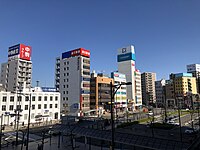

- Western Aichi Prefecture(Owari Province)
- Eastern Aichi Prefecture(Mikawa Province)
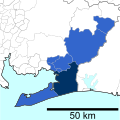


Gifu Prefecture
[edit]

Mie Prefecture
[edit]
Transport
[edit]
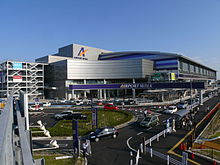

Major airports
[edit]Major railways
[edit]There are at least 38 passenger train lines in the Greater Nagoya area. JR runs six, Nagoya Subway seven, Meitetsu 18, Kintetsu four, and five other operators one each.
- Other operators
Major intercity highways
[edit]- Chita-Hanto Expressway
- Chūō Expressway
- Higashi-Meihan Expressway
- Isewangan Expressway
- Meishin Expressway
- Tōkai Ring Expressway
- Tōkai-Hokuriku Expressway
- Tomei Expressway
Demographics
[edit]Per Japanese census data,[7][8][9] and[10][circular reference] , Chūkyō metropolitan area, also known as greater Nagoya, has had continuous population growth.
| Year | Pop. | ±% |
|---|---|---|
| 1950 | 2,237,000 | — |
| 1960 | 4,297,000 | +92.1% |
| 1970 | 6,603,000 | +53.7% |
| 1980 | 7,777,000 | +17.8% |
| 1990 | 8,407,000 | +8.1% |
| 2000 | 8,740,000 | +4.0% |
| 2010 | 9,107,414 | +4.2% |
| 2020 | 9,552,132 | +4.9% |
See also
[edit]- Nagoya
- Greater Nagoya Initiative
- Chūkyō Industrial Area
- Chūkyō Television Broadcasting
- Chukyo University
- List of metropolitan areas in Japan by population
Notes
[edit]- ^ a b "県内総生産(生産側、実質:連鎖方式)※支出側も同じ-平成27暦年連鎖価格". www.esri.cao.go.jp.
- ^ Demographia World Urban Areas 2019
- ^ a b Kanemoto, Yoshitsugu. "Metropolitan Employment Area (MEA) Data". Center for Spatial Information Science, University of Tokyo. Retrieved January 25, 2019.
- ^ Kanemoto, Yoshitsugu. "Urban Employment Area (MEA) Code Table". Center for Spatial Information Science, University of Tokyo. Archived from the original on January 9, 2019. Retrieved January 25, 2019.
- ^ 2014 GLOBAL METRO MONITOR MAP
- ^ Conversion rates - Exchange rates - OECD Data
- ^ Greater Nagoya
- ^ Chūkyō metropolitan area
- ^ Statistics Bureau of Japan
- ^ List of metropolitan areas in Japan
The area defined by the Chukyo Area Person-Trip Survey, a study of commuter movement, is slightly different from the census definition. It includes southern Aichi and areas immediately north of Gifu City. It adds two cities in Aichi Prefecture (Tahara and Toyohashi) and two cities in Gifu Prefecture (Mino and Seki). Additionally, it excludes two cities in Gifu Prefecture (Ena and Nakatsugawa).




